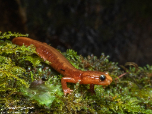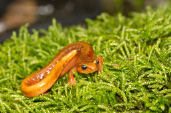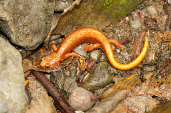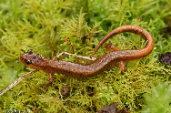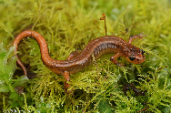Van Dyke's Salamander (Plethodon vandykei)
Description: Van Dyke's salamander has a relatively stocky body and grows up to 10 cm long. There are parotoid glands behind the eyes, and the feet are broad and slightly webbed. Different color phases are described based on body color, which can be black, yellow, or pink. The "dark phase" has a black ground color and yellow or red dorsal stripe. The stripe appears to have drops of color extending down the sides. The "light phase" is tan, yellow or rose with an indistinct stripe. Dark phase individuals have white speckling on the sides and a yellow throat. Multiple color phases can occur within the same population.
Habitat: They generally occur in small isolated populations that are usually associated with streams, seepages, and rock outcrops. Van Dyke's Salamander is absent from the eastern slopes of the Cascade Range and Olympic Range, suggesting this salamander's association with high rainfall regions. In coastal areas, it is mostly found in old forest stands that have moderate to high levels of woody debris and fractured rock present. Large decaying conifer logs along streams appear to be important habitat for nesting.
They are completely terrestrial but require high soil moisture and cool temperatures. They are most active in the spring after snow-melt and in the fall after the onset of the rainy season. They avoid the summer heat and the freezing temperatures of winter, seeking shelter beneath stones or within rotting logs.
Range: Van Dyke's salamander is endemic to the western portion of Washington. It occurs in three disjunct areas: on the Olympic Peninsula, in the Willapa Hills, and in the southern Cascade Range.
Found in these States:
OR |
WA
Diet: A wide variety of small invertebrates, including arachnids, worms, snails, larvae, and insects.
Reproduction: Courtship and egg laying occurs in the spring. Clutch size ranges from 7 to 14 eggs which measure about 4 to 5 mm in diameter. Females attend the eggs until hatching in the fall. There is no larval stage; hatchlings emerge as juvenile salamanders.
Status: Listed as Least Concern in view of its wide distribution, presumed large population, and remaining suitable habitat across its range.
»» Kingdom: Animalia - Animals
»» Phylum: Chordata - Chordates
»» Subphylum: Vertebrata - Vertebrates
»» Class: Amphibia - (Amphibians)
»» Order: Caudata - Salamanders
»» Family: Plethodontidae - Lungless Salamanders
»» Genus: Plethodon
»» Species: Plethodon vandykei - Van Dyke's Salamander
This article uses material from the Wikipedia article "Van Dyke's Salamander", which is released under the Creative Commons Attribution-Share-Alike License 3.0. Content may have been omitted from the original, but no content has been changed or extended.
|





